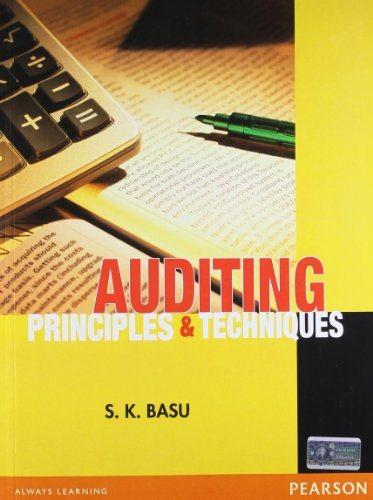Question
P7-74B. (Learning Objectives 1, 2, 3: Computing depreciation by three methods; identifying the cash-flow advantage of accelerated depreciation for tax purposes) On January 6, 20X6,

P7-74B. (Learning Objectives 1, 2, 3: Computing depreciation by three methods; identifying the cash-flow advantage of accelerated depreciation for tax purposes) On January 6, 20X6, K. P. Scott Co. paid 265,000 for a computer system. In addition to the basic purchase price, the company paid a setup fee of 800, 6,400 sales tax, and 27,800 for a special platform on which to place the computer. K. P. Scott management estimates that the computer will remain in service for five years and have a residual value of 30,000. The computer will process 45,000 documents the first year, with annual processing decreasing by 2,500 documents during each of the next four years (that is, 42,500 documents in 20X7; 40,000 documents in 20X8; and so on). In trying to decide which depreciation method to use, the company president has requested a
depreciation schedule for each of the three depreciation methods (straight-line, units-of-produc- tion, and double-declining-balance).
Requirements 1. For each of the generally accepted depreciation methods, prepare a depreciation schedule showing asset cost, depreciation expense, accumulated depreciation, and asset book value.
2. K. P. Scott reports to shareholders and creditors in the financial statements using the depre- ciation method that maximizes reported income in the early years of asset use. For income
tax purposes, the company uses the depreciation method that minimizes income tax pay- ments in those early years. Consider the first year K. P. Scott Co. uses the computer. Iden- tify the depreciation methods that meet Scotts objectives, assuming the income tax
authorities permit the use of any of the methods.
P7-74B. (Learning Objectives 1, 2, 3: Computing depreciation by three methods; identifying the cash-flow advantage of accelerated depreciation for tax purposes) K. P. Scott Co. paid 265,000 for a computer system. In addition to the basic purchase price, the company paid a setup fee of 800, 6,400 sales tax, and 27,800 for a special platform on which to place the computer. K. P. Scott management estimates that the computer will remain in service for five years and have a residual value of 30,000. The computer will process 45,000 documents the first year, with annual processing decreasing by 2,500 documents during each of the next four years (that is, 42,500 documents in 20X7; 40,000 documents in 20X8; and so on). In trying to decide which depreciation method to use, the company president has requested a depreciation schedule for each of the three depreciation methods (straight-line, units-of-produc- tion, and double-declining-balance). Requirements 1. For each of the generally accepted depreciation methods, prepare a depreciation schedule showing asset cost, depreciation expense, accumulated depreciation, and asset book value. 2. K. P. Scott reports to shareholders and creditors in the financial statements using the depre- ciation method that maximizes reported income in the early years of asset use. For income tax purposes, the company uses the depreciation method that minimizes income tax pay- ments in those early years. Consider the first year K. P. Scott Co. uses the computer. Iden- tify the depreciation methods that meet Scott's objectives, assuming the income tax authorities permit the use of any of the methods. P7-74B. (Learning Objectives 1, 2, 3: Computing depreciation by three methods; identifying the cash-flow advantage of accelerated depreciation for tax purposes) K. P. Scott Co. paid 265,000 for a computer system. In addition to the basic purchase price, the company paid a setup fee of 800, 6,400 sales tax, and 27,800 for a special platform on which to place the computer. K. P. Scott management estimates that the computer will remain in service for five years and have a residual value of 30,000. The computer will process 45,000 documents the first year, with annual processing decreasing by 2,500 documents during each of the next four years (that is, 42,500 documents in 20X7; 40,000 documents in 20X8; and so on). In trying to decide which depreciation method to use, the company president has requested a depreciation schedule for each of the three depreciation methods (straight-line, units-of-produc- tion, and double-declining-balance). Requirements 1. For each of the generally accepted depreciation methods, prepare a depreciation schedule showing asset cost, depreciation expense, accumulated depreciation, and asset book value. 2. K. P. Scott reports to shareholders and creditors in the financial statements using the depre- ciation method that maximizes reported income in the early years of asset use. For income tax purposes, the company uses the depreciation method that minimizes income tax pay- ments in those early years. Consider the first year K. P. Scott Co. uses the computer. Iden- tify the depreciation methods that meet Scott's objectives, assuming the income tax authorities permit the use of any of the methodsStep by Step Solution
There are 3 Steps involved in it
Step: 1

Get Instant Access to Expert-Tailored Solutions
See step-by-step solutions with expert insights and AI powered tools for academic success
Step: 2

Step: 3

Ace Your Homework with AI
Get the answers you need in no time with our AI-driven, step-by-step assistance
Get Started


